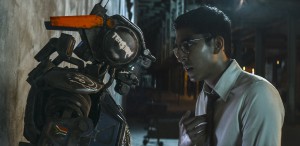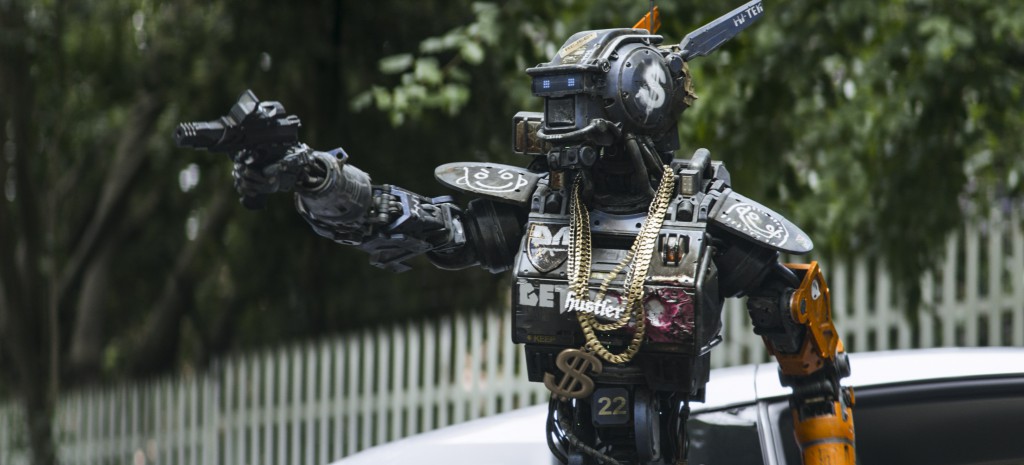‘Chappie’: The Rise (and Fall) of Machines
Man, I knew I was in trouble before the movie even started. I’d settled in my comfy stadium-seating chair, all set for the unspooling of Chappie, a new film about a robot that grows a conscious. I was looking forward to this sci-fi romp from director Neill Blomkamp, whose District 9 was one of the most compelling, audacious movies I’d even seen.
It wasn’t the 20 minutes of ads that alarmed me; I’m used to that. No, the sinking feeling came when the coming attractions burst forth: Furious 7 (the latest—and last—of the Fast and Furious series), Terminator Genisys (the Terminator franchise reboot), Insurgent (Divergent’s sequel), Mad Max Fury Road (another franchise reboot), and the Avengers sequel The Avengers: Age of Ultron.
It was 10 solid minutes of explosions, the plot of each film requiring, for reasons I hope never to know, a tall building to burst into flames. And that worried me because, as the trailers suggested, Hollywood may know nothing about originality, but they take a back seat to no one when it comes to marketing. The cinematic powers-that-be knew something I didn’t: If you’re watching Chappie, you probably like watching buildings explode.
“What have I gotten myself into?” I wondered as I hunkered in my seat. I normally avoid movies like the one this seemed to be, but I’d been lured by my regard for Blomkamp’s work, as well as by the stars Hugh Jackman, Sigourney Weaver, and Dev Patel.
Two hours later, I realized those trailers were merely, cruelly, dangling a carrot; being inside a burning building might be bad, but compared to Chappie, it’s like two weeks on the French Riviera.
If I can bastardize Winston Churchill’s comment: “Never in the history of human conflict have so many done so much and produced so little.” And since I’m digging around the graveyard of dead British guys, let me throw up this quote from Shakespeare (or, as his wife use to call him, “The Immortal Bard”). It’s “full of sound of fury signifying nothing.” How can a movie crammed full of special effects, blood packs, green screen stunts, and armories of armor, on reflection, weigh less than the lint in my pocket? It’s actually difficult to explain Chappie, but take my hand and let’s see if we can get through it together.
Chappie opens a couple of years from now in crime-ridden Johannesburg, South Africa. And I do mean crime-ridden: Gangs roam the city terrorizing everyone, and the city’s police force is helpless. That is until Sigourney Weaver shows up as the CEO of a multinational corporation that manufactures police robots, indestructible machines that bring the criminal element in line. Soon Joburg is on the road to recovery.

Deon (Dev Patel) boots up Chappie with the new program.
Hold on cowboy, not so fast. There’s strife within the company. Dev Patel, the man who invented the robots, is working on something new—a computer program that is not only the latest in artificial intelligence, but also gives robots consciousness. He explains to Weaver that, with this new feature, the robots will have to ability to, among other things, appreciate art! Weaver looks doubtful and pointedly asks: “What the hell good is that for a people-killing machine?” and then kicks him out of her office.
Added to the foray is Hugh Jackman, who also works there. He’s invented “Moose,” a giant military robot that, among other things, flies and shoots down airplanes.
Like Goldilocks sampling the porridge, Weaver concludes that Moose might be a little too lethal, then kicks him out of her office too. Jackman hates Patel because Dev’s program is getting all the R&D money … and Patel hates Jackman because—well, it wasn’t really clear why, except that Jackman seemed a bit Darth Vader-ish.
Out on the streets, Hippo, the king of the criminals, tells rival thugs Ninja, Yolandi, and Amerika that they owe him $22 million for a drug deal gone wrong and have seven days to cough up the cash.
In rapid succession, the plot thickens: Patel decides that Weaver doesn’t know what she’s talking about and steals a robot with plans to install the consciousness software; the street thugs take Patel hostage because they think that because he’s the robots’ creator, he’ll know how to switch off the police force; Jackman hatches a plan to destroy the robots and neutralize Patel so Moose gets the funding it deserves; and an inexplicable Anderson Cooper appears in a cameo as himself, explaining to CNN viewers the parts of the plot that Blomkamp couldn’t explain any other way.
None of that, by the way, is a spoiler, since all this happens in the first five minutes.

Chappie gets corrupted in “the hood.”
The real movie is about “Chappie,” the robot that Patel programs at the thugs’ gunpoint. Named by the thug Yolandi—“It’s a cute little chappie”—it arrives like a baby being born. And although Patel says Chappie—voiced and motion captured by Sharlto Copley—will mature to full-age, it never seems to get beyond the reasoning of a 10 year old.
Chappie (as an innocent) is betrayed by almost every human it comes into contact with, and each encounter involves guns and knives and bombs and rockets and every other weapon imaginable. True, it’s not my kind of film, but since Doris Day stopped making movies decades ago, nothing is my kind of film. I’d say that if it’s your kind of film, then be my guest.
Be forewarned, though, because it doesn’t make much sense. Chappie is one of those movies in which plot and character is plausible only if every person in it (and the audience as well) has had a lobotomy. What’s true in one scene isn’t in the next: The internal logic fueling the conflict at the beginning evaporates in the middle, and the ending has no thematic relevance to the opening.
It’s a critic’s job, when confronted with a scene of devastation such as this, to pick through the rubble and discern exactly what a) the filmmakers were trying to construct, b) why didn’t they, and c) was it worth the bother.
But with Chappie, it’s all such a dreadful pig’s breakfast that an autopsy isn’t even possible. The most humane thing to be done is strap the film to a depth charge and drop it far out to sea. Which may be the reason that Weaver and Jackman, during their scenes, appear to be reconciling their bank statements in their heads. (Just like you and me, big stars have to pay their cable bills.)
I’m tempted to say that the final 10 minutes of Chappie, in which Blomkamp goes to extraordinary lengths setting up a sequel, are ludicrous; I can’t imagine that there’s anyone in the world who would care what happens to the characters after the lights finally come up.
I’m tempted to say that … but if Furious, Terminator, Divergent, Mad Max, and Ultron are any guide, Chappie 2 is right around the bend, as long as they find more buildings to blow up.
And if you want to get in touch with me, I’ll be at home watching Pillow Talk.
Photos courtesy of Sony Pictures
Ted Hoover is a Pittsburgh-based writer and critic.
Share on Social Media
Follow Entertainment Central
Latest Stories
Sign up for the EC Newsletter







